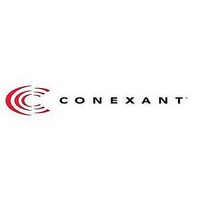RP56D Conexant Systems, Inc., RP56D Datasheet

RP56D
Manufacturer Part Number
RP56D
Description
QFP
Manufacturer
Conexant Systems, Inc.
Specifications of RP56D
Date_code
01+
Available stocks
Company
Part Number
Manufacturer
Quantity
Price
Part Number:
RP56D
Manufacturer:
CONEXANT
Quantity:
20 000
Company:
Part Number:
RP56D(R6764-62)
Manufacturer:
FUJI
Quantity:
78
Company:
Part Number:
RP56D(R6764-63)
Manufacturer:
ROKWELL
Quantity:
120
Part Number:
RP56D(R6764-63)
Manufacturer:
ROKWELL
Quantity:
20 000
Company:
Part Number:
RP56D/R6764-62
Manufacturer:
TOPRO
Quantity:
312
Company:
Part Number:
RP56D/R6764-63
Manufacturer:
ROCKWELL
Quantity:
180
Part Number:
RP56D/R6764-63
Manufacturer:
CONEXANT
Quantity:
20 000
Company:
Part Number:
RP56D/SP
Manufacturer:
PHILIPS
Quantity:
1 831
Part Number:
RP56D/SP
Manufacturer:
PHILIPS/飞利浦
Quantity:
20 000
Introduction
The CONEXANT
Modem Data Pump (MDP) families support data/fax
modem, voice coding/decoding, optional full-duplex
speakerphone, and optional AudioSpan (Table 1). Low
voltage and small size support desktop applications.
Downloadable architecture allows upgrading of MDP code
from the host/DTE.
In V.90/K56flex mode (RP56), the MDP can receive data
at speeds up to 56 kbps from a digitally connected V.90-
or K56flex-compatible central site modem. These MDPs
take advantage of the PSTN which is primarily digital
except for the client modem to central office local loop and
are ideal for applications such as remote access to an
Internet service provider (ISP), on-line service, or
corporate site. The MDP can send upstream data at
speeds up to V.34 rates.
In V.34 data mode (RP56 and RC336), the MDP can
connect at the highest data rate the channel can support
from 33.6 kbps to 2400 bps with auto-fallback to V.32 bis.
In V.32 bis mode, the MDP can connect at the highest
data rate the channel can support from 14.4 kbps to 4800
bps with optional auto-fallback to lower rate modulations.
Internal HDLC support eliminates the need for an external
serial input/output (SIO) device in the DTE for products
incorporating error correction and T.30 protocols.
Voice mode includes an Adaptive Differential Pulse Code
Modulation (ADPCM) voice coder and decoder (codec).
The codec compresses and decompresses voice signals
for efficient digital storage of voice messages. The codec
operates at 28.8k, 21.6k, or 14.4k bps (4-bit, 3-bit, or 2-bit
quantization, respectively) with a 7.2 kHz or 8.0 kHz
sample rate.
A voice pass-through mode allows the host to transmit
and receive uncompressed voice samples in 16-bit linear
form at 7.2 kHz, 8.0 kHz, or 11.025 kHz sample rate, or in
8-bit A-Law/µ-Law PCM form at 8.0 kHz sample rate.
SP models support position-independent full-duplex
speakerphone (FDSP) operation using a dual internal
integrated analog circuit to interface with the telephone
line and the audio input/out (i.e., a headset, handset, or a
microphone with external speaker).
SP models also support AudioSpan (analog simultaneous
audio/voice and data) operation at a data rate of 4.8 kbps.
The MDP operates over the public switched telephone
network (PSTN) through the appropriate line termination.
RP56D, RP336D, and RP144D
Features
Downloadable MDP code from the host/DTE
2-wire full-duplex
2-wire half-duplex
Serial synchronous and asynchronous data
Parallel synchronous and asynchronous data
Parallel synchronous SDLC/HDLC support
In-band secondary channel (V.34 and V.32 bis)
Automatic mode selection (AMS)
Automatic rate adaption (ARA)
Digital near-end and far-end echo cancellation
Bulk delay for satellite transmission
ADPCM voice mode (7.2 kHz or 8.0 kHz)
Voice pass-through mode (7.2 kHz, 8.0 kHz, or 11.025 kHz)
Full-duplex speakerphone (SP models)
AudioSpan (SP models)
TTL and CMOS compatible DTE interface
Dynamic range: -9 dBm to -43 dBm
Adjustable speaker output to monitor received signal
DMA support interrupt lines
Transmit and receive (16+128)-byte FIFO data buffers
NRZI encoding/decoding
511 pattern generation/detection
V.8 and V.8 bis signaling
V.13 signaling
Diagnostic capability
+3.3V operation with +5V tolerant inputs
Power consumption:
Low profile, small footprint package
V.90 and K56flex (RP56 models)
V.34 (33.6 kbps) (RP56 and RP336 models)
V.32 bis, V.32, V.22 bis, V.22, V.23, and V.21
Bell 212 and 103
V.34 fax, V.17, V.33, V.29, V.27 ter, and V.21 ch 2
Bell 208
Short train option in V.17 and V.27 ter
Acoustic and line echo cancellation
Programmable microphone AGC
Microphone volume selection and muting
Speaker volume control and muting; room monitor
ITU-T V.61 modulation (4.8 kbps data plus audio)
Handset, headset, or half-duplex speakerphone
ITU-T V.24 (EIA/TIA-232-E) (data/control)
Microprocessor bus (data/configuration/control)
V.54 inter-DCE signaling
V.54 local analog and remote digital loopback
+5V analog operation
Normal Mode = 280 mW; Sleep Mode = 53 mW
100-pin PQFP












